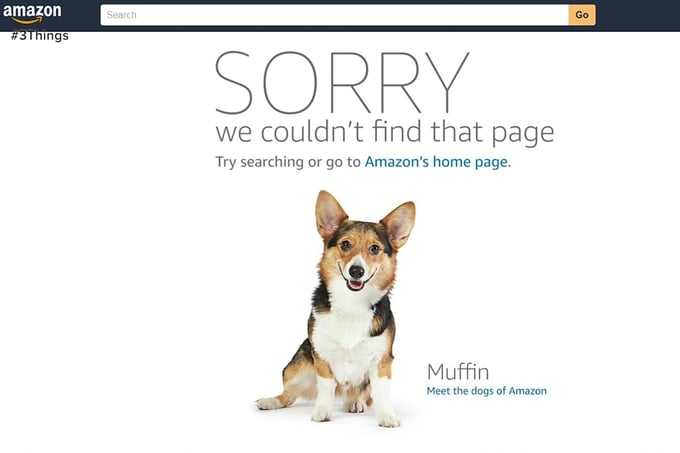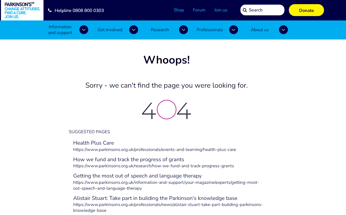23%. That’s the number of website visitors that encounter a broken link, that make a second attempt to find the missing page. That’s not a great number.
The truth is, 404 pages are simply dead ends on your website visitor’s content journey, reducing their velocity towards the content they are looking for and hampering conversions.
Let’s get straight to the point- the way you handle 404s needs an upgrade. There are practical and data-driven ways to create a better customer experience that retains site visitors and increases conversions, even when the link a visitor lands on is broken.
But before we get into that, let’s take a look at the causes and consequences of 404s.
Where are they coming from?
Here’s a fact that most people find surprising- your website only accounts for about 17% of the 404 errors people encounter.
404s often occur when a webpage is renamed or moved. Links are broken when site owners neglect to rename the internal link associated with the webpage. Old URLs should be redirected to a new site with a 301-redirect, but this doesn’t always occur. Additional causes include a change in a web directory, which normally mandates users to alter URLs, or when URLs are deleted or moved without an update. Internal links that aren’t updated within the directory can lead to 404 error messages.
However, on average, the primary causes of 404s are:
- Direct, Typo, Email, Bookmarks- 45.87%
- Referrals & Social Networks- 30.26%
- Broken Link On Your Website- 17.58%
- Search Engine- 6.3%
This means that no matter how diligent you are about crawling your site to rectify errors or setting up redirects, your visitors are still going to hit a large number of 404s through no fault of your own. The upshot of this of course, is that at some point your visitors are going to stumble onto 404 error pages on your site no matter how hard you try.
The consequences of that is significant- 73.72% of people who reach a 404 error page will leave your website and not return.
How serious of a problem is this?
The occurrence of 404s is more pervasive than many organizations realize- in a recent beta test Cludo conducted with a number of large companies like Vodafone Australia, Parkinson’s UK and the Bank of England, thousands of 404 pages a MONTH were served to EACH company’s visitors. That’s a lot of people who didn’t find what they were looking for, especially when real money is at stake.
Visitors hitting broken links can have a considerable impact on your website’s conversion rates, as well your overall brand image. Given that 79% of visitors who are dissatisfied with website performance say they are less likely to buy from the same site again, we can extrapolate that 404s have a direct impact on your ability to connect with and retain potential customers.
Regardless of the money you’ve spent reaching potential clients, your efforts are wasted if they can’t be converted- a high rate of 404 errors should serve as a warning for site owners that wish to use their websites as a gateway to their business- customers hitting 404s are customers hitting dead ends.
At best, sites are currently trying to mitigate this effect by either serving up humorous messages to distract from the fact that the customer has hit a dead end. In recent years, organizations have upped the ante, creating ever more creative and amusing 404 pages.

Though they’re creative, none of them go anywhere.
How to build a better 404 page
The key to moving visitors through your site seamlessly, is to stop thinking of your 404 page as a static entity, and instead reimagine it as a dynamic landing page.
The problem with 404 pages in their current state, is that they are more focused on apologizing for a missing page, rather than moving the visitor to the content they were looking for.
We are now technologically equipped to offer visitors a seamless and meaningful experience. A truly dynamic and useful alternative to the classic 404 requires 2 key aspects:
- It should be predictive, offering the visitor options relevant to their intended content.
- It should be intuitive, offering the visitor an easy path towards that content.
This means that from a usability perspective, while you briefly acknowledge that the link is broken, the main focus of the 404 page are the suggested pages you immediately offer the visitor.
The best way to achieve this is to employ a machine learning solution (ML), similar to that used by a site search engine. The ML engine can utilize a variety of data points to identify pages that retrieve pertinent results for a visitor when they hit a nonexistent page. It attains relevance across millions of search queries, and learns, refines and improves results automatically. Patterns of behavior are identified, and the most up-to-date results are shown, even when a 404 page is encountered.
By creating a dynamic page that has relevant options for the visitor prominently displayed, you will vastly increase the stickiness of your website and improve overall conversion rates by keeping visitors engaged.
Here are some examples of 404 pages that really work:

https://www.parkinsons.org.uk/event
https://childrensnational.org/providers
Utilizing 404 data to improve customer engagement
Beyond creating a better visitor experience, Intelligent 404 pages are also a source of highly useful data. 404 analytics will help you track how many 404s are being generated on your site, where visitors are migrating to from those pages, and what the success rate is for those being diverted. By diving into this data, you can gain a clearer picture of what content is working on your site, and where your gaps are. Understanding this data allows you to receive a clearer picture of content that is well received on your site, and gaps that need to be filled for increased user engagement.
The best way to measure the accuracy of your Intelligent 404 is via a Mean Reciprocal Rank (MRR). The MRR score is a statistical measure for evaluating any process that produces a list of possible responses to a sample of queries, ordered by probability of correctness. For instance, the Reciprocal Rank is 1 if a relevant link was presented at rank 1, if not, it is 0.5 if a relevant link was retrieved at rank 2 and so on. When averaged across queries, the measure it gives you is your MRR score.
A well-constructed Intelligent 404 page will deliver relevant results with a high MRR score, keeping individuals engaged on your site, and retaining the attention of your user base. In simple terms, it’ll get people to stick around and help you convert them into customers.
It’s also important that you continually identify and fix 404s occurring locally to keep your website performing at its best. A lot of organizations aren’t even aware of the number of 404s being generated by their websites, but every one of those is a missed opportunity for better customer engagement.
Implementing an out-of-the-box Intelligent 404 solution
Building and maintaining a machine learning driven system, which is especially vital for larger websites, takes time, technical knowledge, and ongoing resource commitments. If that capacity does not exist at your organization, an out-of-the-box solution can work wonders for your website.
Cludo recently launched a first of its kind: truly machine learning driven 404 pages that offer intelligent pathways to content that is relevant to website visitors, when the URL they land on does not exist. The power of these pages has been borne out in- in a recent beta test, Cludo’s Intelligent 404 pages moved 1,510 visitors from a broken link to a relevant page on average per month for EACH customer!
You can learn more about Cludo’s Intelligent 404 here, or simply try it out for yourself by requesting a demo.